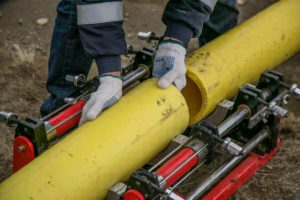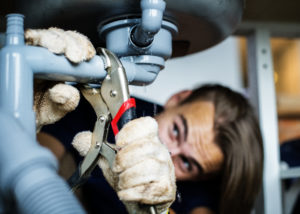In commercial plumbing, backflow issues can pose significant challenges for businesses. As a seasoned plumber, I’ve seen the consequences of neglecting backflow prevention and recognize the importance of addressing it promptly. In this article, we’ll provide a comprehensive overview of commercial backflow, its common causes, preventive measures, and the procedures to handle each scenario.
What is Commercial Backflow?
Commercial backflow refers to the unwanted reversal of water flow in a plumbing system. This can lead to contaminated water, which is a mixture of clean water with hazardous substances, flowing back into the clean water supply. Such a scenario is not only a health hazard but can also lead to significant business disruptions and potential legal implications like these:
Significant Business Disruptions
- Health concerns: Backflow can introduce contaminants into the potable water supply, leading to potential health issues for employees and customers. This can result in absenteeism and potential closure of the business until the issue is resolved.
- Operational delays: Contaminated water can disrupt daily operations, especially for businesses that rely heavily on water, such as restaurants, hotels, and manufacturing units.
- Reputation damage: News of water contamination can spread quickly, leading to negative publicity and loss of trust among customers.
- Cost implications: Addressing backflow issues can be costly, especially if the plumbing system requires extensive repairs or replacements. There’s also the potential cost of medical treatments for affected individuals.
Legal Implications in Pennsylvania
According to the Pennsylvania Code & Bulletin, the following legal stipulations apply
- Backflow prohibition: Backflow is not permitted in Pennsylvania. A potable water distributing pipe must be protected against backflow from any plumbing fixture or equipment capable of affecting the water quality in the potable water supply. This protection can be achieved by providing an air gap of at least twice the diameter of the water supply pipe.
- Backflow preventer assembly: If it’s not feasible to provide the minimum air gap, the connection to the fixture, equipment, or appliance must be equipped with a backflow preventer assembly approved by the Department.
- Fixed potable water outlet: The Department may require the installation of a backflow preventer assembly at a fixed potable water outlet where a hose might be connected and used in contact with potentially contaminating liquids or substances.

Failure to adhere to these regulations can result in penalties, fines, and potential legal action by the state. Businesses may also be held liable for any health issues that arise due to water contamination caused by backflow.
It’s essential for businesses to be aware of these regulations and ensure that their plumbing systems are compliant to avoid potential legal repercussions
Procedures for Addressing Commercial Backflow Based on Common Scenarios
- Pressure Imbalances
The most common cause of backflow is a sudden drop in water pressure, often referred to as back-siphonage. This can be due to various reasons such as a water main break or heavy water withdrawal because of firefighting activities.
- Identification: Utilize pressure gauges to monitor the water pressure within the system. A sudden drop in pressure can indicate potential back-siphonage.
- Isolation: Shut off the main water supply to the affected area to prevent further contamination.
- Correction: Identify the cause of the pressure drop. If it’s due to external factors like a water main break, wait for the issue to be resolved by the local water authority. If it’s an internal issue, inspect the system for leaks or damages and repair them.
- Testing: Once repairs are done, monitor the water pressure to ensure it remains stable. Install pressure regulators if necessary to maintain consistent pressure.
- Cross-Connections
These are points in a plumbing system where the potable water supply is connected to a non-potable source. If not properly managed, cross-connections can lead to backflow incidents.
- Identification: Conduct a thorough inspection of the plumbing system to identify any points where potable and non-potable water sources might be connected.
- Isolation: Shut off the water supply to any identified cross-connections.
- Correction: Install appropriate backflow preventers at each cross-connection point. This ensures that even if there’s a pressure imbalance, contaminated water won’t flow back into the potable water supply.
- Testing: After installing backflow preventers, test each one to ensure they function correctly. Regularly inspect these devices for wear and tear.
- Equipment Malfunctions
In commercial settings, various equipment pieces are connected to the water supply. A malfunction in any of these can lead to backflow.
- Identification: Regularly inspect equipment connected to the water supply. Look for signs of malfunction, such as unusual noises, leaks, or decreased performance.
- Isolation: Disconnect malfunctioning equipment from the water supply.
- Correction: Repair or replace the malfunctioning equipment. Ensure that any equipment connected to the water supply has the necessary safeguards in place to prevent backflow.
- Testing: After repairs or replacements, test the equipment to ensure it operates correctly without causing any backflow issues.
Preventing commercial backflow
Installation of commercial backflow preventers: These are specialized devices designed to prevent the reversal of water flow. They automatically shut off the water flow if a reversal is detected. Here are the most commonly used backflow preventers and their unique features:
- Reduced Pressure Zone (RPZ) Device:
- Unique feature: This device has two independent check valves with a pressure-monitored chamber between them. If either check valve fails, the chamber will release the water, ensuring no backflow occurs.
- Best Used For: High-hazard applications where there’s a significant risk of contamination.
- Double Check Valve Assembly (DCVA):
- Unique feature: Consists of two check valves installed in series. This dual-check system ensures that if one valve fails, the other can still prevent backflow.
- Best used for: Situations with a moderate risk of contamination.
- Pressure Vacuum Breaker (PVB):
- Unique feature: It has a spring-loaded check valve that will close if pressure drops, and an air relief valve that opens to break any siphon.
- Best used for: Irrigation systems and other non-potable water systems where back-siphonage is a concern.
- Atmospheric Vacuum Breaker (AVB):
- Unique feature: Relies on air pressure and gravity to prevent backflow. It’s simpler in design compared to other devices.
- Best used for: Point-of-use applications, such as at a hose bib, where only back-siphonage is a concern.
- Spill-Resistant Vacuum Breaker (SVB):
- Unique feature: Similar to PVB but designed to minimize water spillage during operation.
- Best used for: Indoor applications where water spillage from a PVB might be problematic.
Regular inspections and maintenance of these devices are crucial. Over time, wear and tear can reduce their effectiveness, so it’s essential to have them checked by professionals to ensure they function correctly.
Regular inspections: Regular inspections by professional plumbers can help in identifying potential backflow risks. This includes checking for cross-connections and ensuring that all equipment is functioning correctly.
Employee training: Employees should be trained to recognize the signs of potential backflow issues and to take immediate action if they suspect a problem.
Conclusion
Commercial backflow is not just a plumbing issue; it’s a matter of public health, business continuity, and legal compliance. In Pennsylvania, the regulations are clear: backflow is not permitted, and businesses must take proactive measures to prevent it. By understanding the potential business disruptions and the legal implications in the state, it becomes evident that investing in proper backflow prevention is not just a good practice but a necessity. If your business seeks guidance on backflow prevention or requires commercial backflow services, trust the experts at Action Plumbing. Their extensive experience in commercial plumbing ensures that your business remains compliant, safe, and operational.
